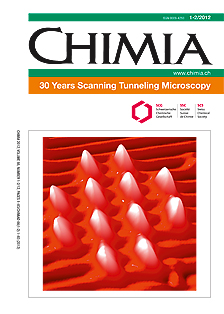Spin-Polarized Scanning Tunneling Microscopy: Breakthroughs and Highlights
DOI:
https://doi.org/10.2533/chimia.2012.56Keywords:
Spin-polarized scanning tunneling microscopy (sp-stm)Abstract
The principle of scanning tunneling microscopy, an imaging method with atomic resolution capability invented by Binnig and Rohrer in 1982, can be adapted for surface magnetism studies by using magnetic probe tips. The contrast mechanism of this so-called spin-polarized scanning tunneling microscopy, or SP-STM, relies on the tunneling magneto-resistance effect, i.e. the tip–sample distance as well as the differential conductance depend on the relative magnetic orientation of tip and sample. To illustrate the working principle and the unique capabilities of SP-STM, this compilation presents some key experiments which have been performed on various magnetic surfaces, such as the topological antiferromagnet Cr(001), a double-layer of Fe which exhibits a stripe- domain pattern with about 50 nm periodicity, and the Mn monolayer on W(110), where the combination of experiment and theory reveal an antiferromagnetic spin cycloid. Recent experimental results also demonstrate the suitability of SP-STM for studies of dynamic properties, such as the spin relaxation time of single magnetic nanostructures.Downloads
Published
2012-02-29
Issue
Section
Scientific Articles
License
Copyright (c) 2012 Swiss Chemical Society

This work is licensed under a Creative Commons Attribution-NonCommercial 4.0 International License.
How to Cite
[1]
M. Bode, Chimia 2012, 66, 56, DOI: 10.2533/chimia.2012.56.







